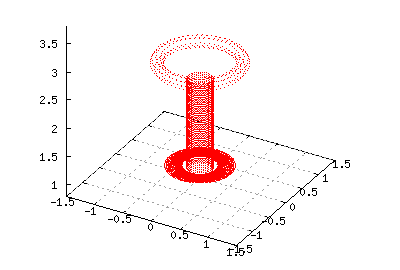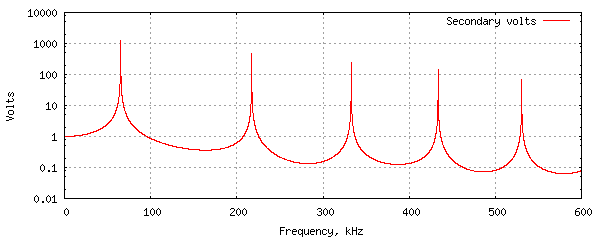
This example models the Tesla coil 'Thor' which was built as a postgrad research project by Marco Denicolai. It is a very well documented and measured system and therefore a good test case for LCnetgen.
Input file thor.in contains
electrode {
name ground
disc { ; Floor
radius 5
center 0,0,0
axis 0,0
}
cylinder { ; Walls
radius 5
end1 0,0,0
axis 0,0
length 6
}
disc { ; Roof
radius 5
center 0,0,6
axis 0,0
}
}
electrode { ; Toroidal topload
name topload
toroid {
outer_radius 0.7575
inner_radius 0.5575
center 0,0,2.85
axis 0,0
}
}
coil { ; Flat spiral primary
name primary
radius1 0.275
radius2 0.545
end1 0,0, 0.995 + 51e-3 ; Set for measured k=0.187
length 0 ; Flat spiral, therefore zero length
axis 0,0 ; Vertical axis
turns 9.5
tap 7.5
wirad 0.4e-2
}
coil { ; Cylindrical secondary
name secondary
radius 0.20
length 1.575
end1 0,0, 0.995
axis 0,0 ; Vertical axis
turns -939
wirad 0.725e-3
}
Generate a Spice sub-circuit and a tiles file from thor.in with the command
lcng -o spice -o tiles thorView the system (excluding the floor, walls and roof) with the gnuplot commands
set terminal x11 set style data dots set view equal xyz set xrange [-1.5:1.5] set yrange [-1.5:1.5] set zrange [0.8:3.8] set grid set xyplane 0 unset key splot 'thor.tiles' using 1:2:3to get something like

This circuit just injects an AC voltage into the secondary base so that we can see where the resonances are from a plot of the top voltage. The Spice file thor-steady.spice contains
Thor .OPTIONS NOMOD NOPAGE .AC LIN 10K 1K 600K .PRINT AC V(2) .INCLUDE thor.spice * 1 volt AC applied to base Vin 0 1 DC 0 AC 1.0 X1 0 2 0 1 2 0 3 4 thor .ENDRun the above Spice circuit with something like
ngspice -b thor-steady.spice > thor-steady.outPlotting the secondary voltage produces

1/4 wave: measured = 65.5kHz, modelled = 65.1kHz, error = -0.6% 3/4 wave: measured = 222.8kHz, modelled = 217.25kHz, error = -2.5% 5/4 wave: measured = 346.3kHz, modelled = 332.9kHz, error = -3.9%
Thor is fired with the 96.7nF primary capacitor charged to 14kV. The Spice file thor-trans.spice contains
Thor .OPTIONS NOMOD NOPAGE .TRAN 100nS 400uS UIC .PRINT TRAN I(VP) I(VB) V(10) .INCLUDE thor.spice VP 0 1 DC 0 AC 0 RGAP 1 2 1.0 CPRI 2 3 96.7n ic=14KV VB 0 6 DC 0 AC 0 X1 0 10 0 6 10 0 3 5 thor RL 10 0 50000K .ENDRun this with the command
ngspice -b thor-trans.spice > thor-trans.out
With Tesla coils, the secondary base current waveform provides the best
diagnostic. The following graph compares the modelled base current with
the actual base current waveform recorded by Marco.
